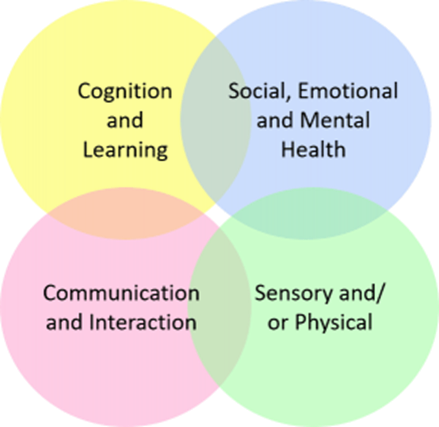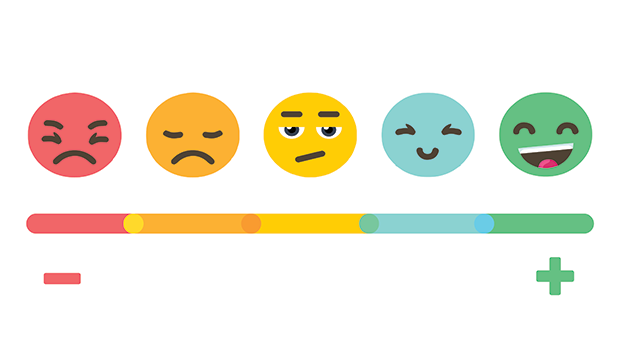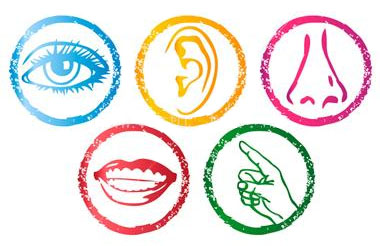
SEND - The Four Areas of Need
The SEND Code of Practice 2014 (updated January 2015) sets out four broad areas of special educational need that include a range of difficulties and conditions:
- Communication and Interaction (C&I)
- Cognition and Learning (C&L)
- Social, Emotional and Mental Health difficulties (SEMHD)
- Physical and/or Sensory Needs (P&SN)
At Bishop Martin C.E Primary School pupils will be identified by their primary area of need. The purpose of identification is to work out what action the school needs to take to support them, not to fit a student into a category or label them.
The code states that:
‘Many children and young people have difficulties that fit clearly into one of these areas; some have needs that span two or more areas; for others the precise nature of their need may not be clear at the outset.’
.jpg)
1. Communication and Interaction
Some of the aspects of difficulty included in this area are:
Autistic Spectrum Disorder (ASD) - ASD is a relatively new term that recognises there are a number of sub-groups within the spectrum of autism. Pupils with ASD find it difficult to:
- understand and use non-verbal and verbal communication
- understand social behaviour, which affects their ability to interact with children and adults
- think and behave flexibly, which may be shown in restricted, obsessional or repetitive activities.
Pupils with ASD cover the full range of ability and the severity of their impairment varies widely. Some pupils also have learning disabilities or other difficulties, making diagnosis difficult.
Pupils with Asperger's syndrome should be recorded in this category. These pupils share the same triad of impairments but have higher intellectual abilities and their language development is different from the majority of pupils with autism.
Speech, Language and Communication Needs (SLCN) - Children and young people may have a range of difficulties with speech and language, some of which may resolve as the student develops.
For some children, such difficulties may be confined to their production of speech. For others, it may be hard to find the right words or to join them together meaningfully in expressive language. They may have problems in communicating through speech and may find it hard to acquire language and express thoughts and ideas. They may experience difficulties or delays in understanding or responding to verbal cues from others, or in understanding and using appropriate language for social interaction.
The fact that a child or young person may understand and speak English as an additional language does not in itself constitute a speech and language difficulty. It is important to note, however, that different languages have different structures/phonologies (sound systems) which can sometimes cause initial short term difficulties.

2. Cognition and Learning
Aspects of difficulty included in this area are:
Attention deficit hyperactivity disorder (ADHD) - Attention Deficit Hyperactivity Disorder is a complex condition can seriously affect a child’s concentration, behaviour and learning. A child with ADHD will often feel easily bored, may be distracted by unimportant sounds and sights, be impulsive and find it hard to sit still. This impacts on their learning as they can find it very hard to concentrate for the periods of time needed to complete tasks. Consequently, the work that they produce may not necessarily reflect their true ability.
Moderate Learning Difficulty (MLD) - Pupils with MLDs will have attainments significantly below expected levels in most areas of the curriculum despite appropriate interventions. Their needs will not be able to be met by normal differentiation and the flexibilities of the National Curriculum.
They should only be recorded as MLD if additional educational provision is being made to help them to access the curriculum. Pupils with MLDs have much greater difficulty than their peers in acquiring basic literacy and numeracy skills and in understanding concepts. They may also have an associated speech and language delay, low self-esteem, low levels of concentration and under-developed social skills.
Profound and Multiple Learning Difficulty (PMLD) - Pupils with profound and multiple learning difficulties have complex learning needs. In addition to very severe learning difficulties, pupils have other significant difficulties such as physical disabilities, sensory impairment or a severe medical condition. Pupils require a high level of adult support, both for their learning needs and also for their personal care. They are likely to need sensory stimulation and a curriculum broken down into very small steps. Some pupils communicate by gesture, eye pointing or symbols, others by very simple language. Their attainments are likely to remain in the early P-scale range (P1-P4) throughout their school careers (that is below level 1 of the National Curriculum).
Severe Learning Difficulty (SLD) - Pupils with Severe Learning Difficulties (SLD) have significant intellectual or cognitive impairments. This has a major effect on their ability to participate in the school curriculum without support. They may also have difficulties in mobility and co-ordination, communication and perception and the acquisition of self-help skills. Pupils with severe learning difficulties will need support in all areas of the curriculum.
They may also require teaching of self-help, independence and social skills. Some pupils may use sign and symbols but most will be able to hold simple conversations.
Specific Learning Difficulty (SpLD) - A child or young person with a Specific Learning Difficulty may have difficulty with one or more aspects of learning. This includes a range of conditions such as dyslexia (difficulties with reading and spelling); dyscalculia (maths); dyspraxia (co-ordination) and dysgraphia (writing).
Dyscalculia - Pupils with dyscalculia have difficulty in acquiring mathematical skills. Pupils may have difficulty understanding simple number concepts, lack an intuitive grasp of numbers and have problems learning number facts and procedures.
Dysgraphia - Pupils with dysgraphia are affected by an extreme difficulty with fine motor skills and can have trouble organising letters, numbers and words on a line or page. This can result partly from:
- Visual-spatial difficulties: trouble processing what the eye sees
- Language processing difficulty: trouble processing and making sense of what the ear hears.
Dyslexia - Pupils with dyslexia have a marked and persistent difficulty in learning to read, write and spell, despite progress in other areas. Pupils may have poor reading comprehension, handwriting and punctuation. They may also have difficulties in concentration and organisation, and in remembering sequences of words. They may mispronounce common words or reverse letters and sounds in words.
Dyspraxia - Pupils with dyspraxia are affected by an impairment or immaturity of the organisation of movement, often appearing clumsy. Gross and fine motor skills are hard to learn and difficult to retain and generalise. Pupils may have poor balance and coordination and may be hesitant in many actions (running, skipping, hopping, holding a pencil, doing jigsaws, etc). Their articulation may also be immature and their language late to develop. They may also have poor awareness of body position and poor social skills.

3. Social, Emotional and Mental Emotional Health
Children with emotional difficulties include those who may be withdrawn or isolated, hyperactive and lack concentration; those with immature social skills and those presenting other difficulties arising other complex needs.
Some children may have emotional needs and/or social problems that interfere with their own ability to learn effectively. In some instances, the difficulties they experience may cause disruption to the learning of other children or young people.
Social difficulties, in this context, occur when students have problems managing interactions with others in school effectively and appropriately. They may have difficulty making the necessary adjustments to conform to the expectations of others in a variety of settings. The process is known as socialisation. Either difficulty may impact substantially on the child’s
ability to learn.
Some of the aspects of difficulty included in this area are:
Adjustment Disorders - A child suffering from an Adjustment Disorder may have witnessed a stressful event or had a big change in their normal lifestyle. This could then have an adverse reaction on their emotional health and/or behaviour.
Anxiety Disorders - A child suffering from an Anxiety Disorder may be prone to frequent panic attacks. Here the child may complain of physical symptoms such as headaches or stomach aches. The child may also display inappropriate emotional responses, such as outbursts of laughter or crying out of context
Obsessive-Compulsive Disorder ('OCD') - A child suffering from EBD may also have an Obsessive Compulsive Disorder (OCD). Here the child can display recurrent and persistent obsessions or compulsions. Behaviours may include repetitive hand washing, praying, counting, and repeating words silently.

4. Sensory and/or Physical
Some of the aspects of difficulty included in this area:
Hearing Impairment (HI) - Pupils with an HI range from those with a mild hearing loss to those who are profoundly deaf. They cover the whole ability range.
For educational purposes, pupils are regarded as having an HI if they require hearing aids, adaptations to their environment and/or particular teaching strategies to access the concepts and language of the curriculum. A number of pupils with an HI also have an additional disability or learning difficulty. Hearing loss may be because of conductive or sensorineural problems and can be measured on a decibel scale. Four categories are generally used: mild, moderate, severe and profound. Some pupils with a significant loss communicate through sign instead of, or as well as, speech.
Visual Impairment (VI) - A visual impairment is generally defined as an eyesight problem that cannot be corrected by wearing glasses or contact lenses or by surgery.
The terms partially sighted, low vision, legally blind, and totally blind are used in the educational context to describe students with visual impairments. They are defined as follows:
- "Partially sighted" indicates some type of visual problem has resulted in a need for special education;
- "Low vision" generally refers to a severe visual impairment, not necessarily limited to distance vision. Low vision applies to all individuals with sight who are unable to read the newspaper at a normal viewing distance, even with the aid of eyeglasses or contact lenses. They use a combination of vision and other senses to learn, although they may require adaptations in lighting or the size of print, and, sometimes, Braille;
- "Legally blind" indicates that a person has less than 20/20 vision in the better eye or a very limited field of vision (20 degrees at its widest point); and
- Totally blind students learn via Braille or other non-visual media.
Multi-Sensory Impairment (MSI) - Pupils with MSI have a combination of visual and hearing difficulties. They are sometimes referred to as deafblind but may have some residual sight and/or hearing. Many also have additional disabilities but their complex needs mean it may be difficult to ascertain their intellectual abilities. Pupils with MSI have much greater difficulty accessing the curriculum and the environment than those with a single sensory impairment. They have difficulties in perception, communication and in the acquisition of information. Incidental learning is limited. The combination can result in high anxiety and multi-sensory deprivation. Pupils need teaching approaches that make good use of their residual hearing and vision, together with their other senses. They may need alternative means of communication.
Physical Disability (PD) - There is a wide range of physical disabilities and pupils cover the whole ability range. Some pupils are able to access the curriculum and learn effectively without additional educational provision. They have a disability but do not have an SEND. For others, the impact on their education may be severe.
In the same way, a medical diagnosis does not necessarily mean a pupil has an SEND. It depends on the impact the condition has on their educational needs.
There are a number of medical conditions associated with physical disability that can impact mobility. These include cerebral palsy, heart disease, spina bifida and hydrocephalus, and muscular dystrophy. Pupils with physical disabilities may also have sensory impairments, neurological problems or learning difficulties.
Some pupils are mobile but have significant fine motor difficulties that require support.
Others may need augmentative or alternative communication aids.

.png)